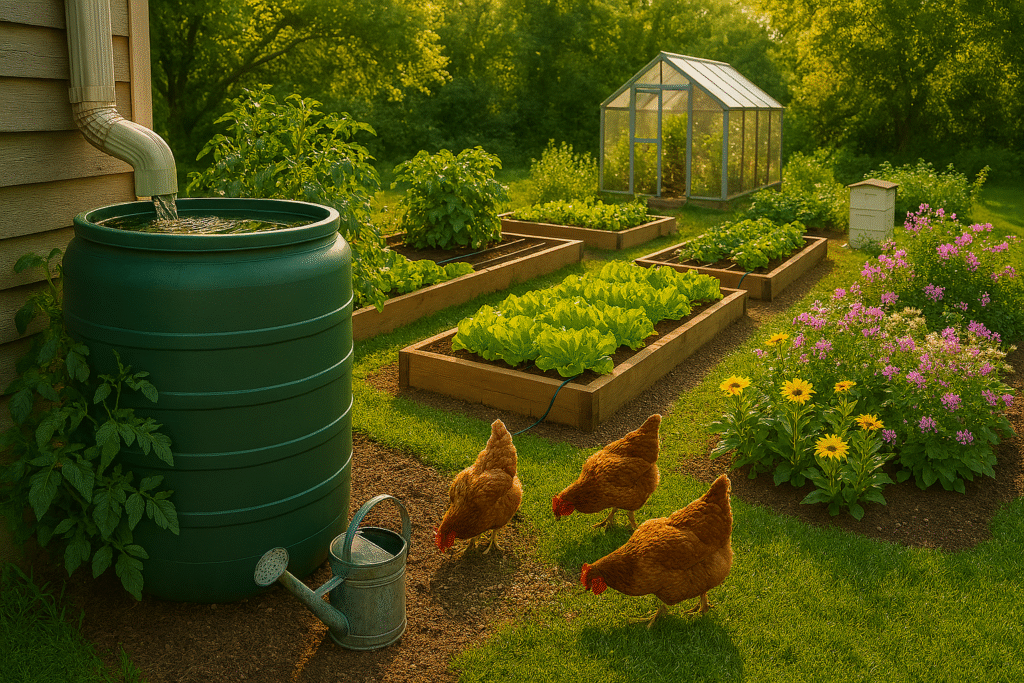Why Water Conservation Matters
Water isn’t just a utility bill—it’s life for your garden, livestock, and household. Conserving water reduces your environmental footprint, saves money, and helps protect local water supplies. Whether you live in a drought-prone region or simply want to live more sustainably, effective water management is a game-changer for any homestead.

Collecting Rainwater
Rainwater harvesting is one of the simplest and most cost-effective ways to secure a sustainable water source. With the right setup, you can use rainwater for irrigation, washing tools, or even filtered household use.
Steps to Get Started:
- Install Rain Barrels or Cisterns – Place under gutter downspouts to capture runoff.
- Use a First-Flush Diverter – Ensures cleaner water by diverting initial roof debris.
- Add a Fine Mesh Screen – Keeps out leaves, mosquitoes, and other pests.
- Plan for Overflow – Direct excess water away from your home’s foundation.
Recommended Products:
- Rain Barrel Kit – Available at Ace Hardware or Amazon.
- Leaf Guard Gutter Filters – Protects your system from clogging.
- Water Pumps – For moving collected water to garden beds.
Greywater Recycling
Greywater is wastewater from sinks, showers, and washing machines (excluding toilets). With a filtration and distribution system, you can reuse it for irrigation.
Tips for Safe Greywater Use:
- Use biodegradable, non-toxic soaps.
- Avoid water from kitchen sinks with grease-heavy residue.
- Distribute greywater directly to soil—not on edible plant leaves.
Popular Systems:
- Laundry-to-Landscape Kits – Easily redirect washing machine water.
- Greywater Diverter Valves – Switch between sewer and garden use.
Efficient Irrigation Methods
Instead of flooding your garden with a hose, opt for methods that deliver water directly to the roots.
Best Practices:
- Drip Irrigation – Conserves up to 50% more water than sprinklers.
- Soaker Hoses – Slow, steady watering without evaporation loss.
- Moisture Sensors – Prevent overwatering by tracking soil hydration.
Mulching for Moisture Retention
Mulch is your garden’s best friend for reducing evaporation, suppressing weeds, and improving soil health.
Types of Mulch:
- Organic Mulch – Wood chips, straw, shredded leaves.
- Inorganic Mulch – Landscape fabric, gravel.
Pro Tip: Lay mulch 2–4 inches deep around plants to hold in moisture without suffocating roots.
Drought-Resistant Landscaping
Also called xeriscaping, this involves planting low-water-use species and designing your landscape to require minimal irrigation.
Ideas:
- Choose native plants adapted to your climate.
- Group plants by water needs.
- Use gravel or stone pathways to reduce thirsty turf areas.
Water Storage & Safety
If you’re storing large amounts of water, keep it clean and safe.
Storage Tips:
- Use food-grade storage containers.
- Keep tanks shaded to prevent algae growth.
- Add water treatment drops if storing for long-term emergency use.
Quick Product Checklist
- Rain barrels (50–100+ gallon capacity)
- First-flush diverters
- Leaf guards & gutter filters
- Greywater diverter valves
- Drip irrigation kits
- Soaker hoses
- Mulch (organic or inorganic)
- Water storage tanks & treatment tablets
Final Thoughts
Water conservation doesn’t mean going without—it means using what you have wisely. By collecting rainwater, recycling greywater, and practicing smart irrigation, you’ll save money, protect resources, and ensure your homestead thrives even in dry spells. Start with one small change, and before you know it, you’ll have a water-smart system that keeps your garden green and your conscience clear.
